This elegant new beach resort features seamless indoor/outdoor living spaces and local stylistic flourishes. A true collaboration between hotelier and design studio, Adrian Zecha chose the team at Noor to bring his vision of clean lines and contemporary design together.
Azerai is a new story and brand of resorts offering guests simple elegance, refined design, and discreet and attentive service in places of unique beauty and cultural interest. The brand was formed by hotelier Adrian Zecha, and the name is derived from his initials and the latter part of a Persian word, caravanserai, which references the storied old inns of the Middle East.
Located 180km east of Ho Chi Minh City, Azerai Ke Ga Bay sits on one of Vietnam’s most desirable perches, on a pristine 5km white-sand beach overlooking the East Sea. Yet the fabulous ocean views may be upstaged by the property’s remarkable transformation in design and architecture.
The resort opened last year following the total refurbishment of Princess D’Annam Resort & Spa, a one-time landmark among Vietnamese beachgoers that had been stuck in the doldrums in recent years.
The buildings’ exteriors have been extensively repaired and repainted, while the interiors have received all-new layouts and finishes, along with updated modern furniture, high-quality furnishings and enhanced lighting. The resort’s 46 guest suites now evoke a stylish aesthetic defined by elegance and clean minimalism, with 10 units boasting either plunge pools or larger private pools.
“We wanted to create a more contemporary and pure design look,” says David Hodkinson, a partner at Noor Design, the Ho Chi Minh City-based architecture and design firm that helped revitalise the resort. “One of the key elements was to open up the rather enclosed and insular spaces of the former resort, connecting them to the landscape and surroundings,” he adds.
Steven Scott, executive director at Azerai Resorts, says the goal was to replan the interior design, opening areas to more natural light and encouraging seamless indoor/outdoor living spaces, both in the guest suites and public areas: “Architecturally, the resort was well designed, with colonial representation of tropical architecture – lots of soaring high ceilings and clustered buildings, which flowed amid the mature landscape. It simply needed someone to look at the place with fresh ideas and bright eyes.”
The materials used in the new resort were all locally sourced in Vietnam and feature a notable increase in natural stone and timber, which makes for all sorts of visual warmth. The colour palette throughout is muted, simple and relaxing, encouraging guests to embrace a laid-back, ‘at-the-beach’ mindset.
Other nods toward Vietnamese design include woven rattan and seagrass matting, pebble-wash flooring using local sand and pebbles, paint colours inspired by the rock formations near the region’s iconic lighthouse, and items crafted by local artisans. Traditional Vietnamese architectural details can also be found in the wooden screens in guest suites and at the resort’s restaurant. “The resort takes design cues from a modernist Vietnamese architectural aesthetic, with clear links to 1950s and ’60s architecture of Vietnam,” says David.
Azerai Ke Ga Bay’s generous proportions induce a “luxurious feel,” says David. The layout includes four public pools in different areas. Rooms – whether deluxe suites (65m2) or pool suites (130m2)-are spacious compared to other resorts in the area.
This spaciousness is one of the property’s many calling cards, says GM Ketut Bagiartha. “Those of us who live in cities rarely have enough space, be it indoors or outdoors. At Azerai Ke Ga Bay, we have the luxury of almost private garden living, complemented with the exclusive grandeur of the resort’s public areas,” he says.
The public areas fronting the beach have been replanned. Stairs sweep down past daybeds to the pool terrace and a sunken lounge, and the area creates one large area for dining, lounging and leisure. The space offers a high degree of privacy while at the same time providing a sense of intimacy.
“There are many unique features to the resort, but one of my favourites is the connection between the beachfront pool and terraces with the landscape, beach and sea beyond,” says David. “The open-stepped wall gives an unblocked view out towards the sea, creating a theatre auditorium feeling, with the sea and sky as the stage.”
The resort’s four swimming pools were all retiled and wide, gradual steps were installed, allowing guests more places to sit and relax in the water. Some of the frangipani trees at the beach pool are more than 50 years old, and add to the timeless feel of the resort.
The oceanfront spa, with views over the beach toward the lighthouse, has been completely redesigned, from the 10 private treatment rooms (six single rooms and four double rooms) to individual or shared relaxation lounges and daybeds, a beauty studio, a Jacuzzi, and a gym with the latest cardiovascular and strength-training equipment.
“The spa has been designed as its own entity, with a processional entranceway,” says David. “Guests arrive at a small welcome pavilion, from which they walk a frangipani-lined pathway to the main spa building. The materials and colours emanate [PF1] the surrounding landscape, with a calming water feature placed at the centre.”
Azerai Ke Ga Bay marks the brand’s first beach resort, and follows Azerai La Residence, Hue, a historic city resort overlooking the Perfume River in Vietnam’s former imperial capital, and Azerai Can Tho, a peaceful retreat set on a lush islet in the Mekong Delta.



